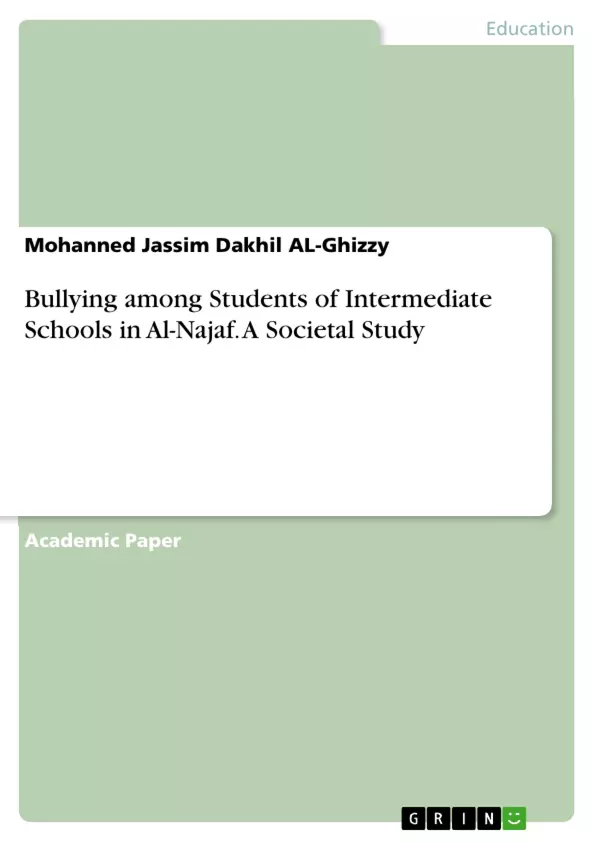The current study is an attempt to discover forms of bullying that students expose in Iraqi intermediate schools, characteristics of bullies/victims, and sittings and timings in which bullying occurs. It is a descriptive societal study in one of the Iraqi Govenorates which is Al-Najaf Al-Ashraf. The data was collected from Iraqi intermediate school students by means of face-to-face interviews. The total number of participants is (2000), (1000) boys and (1000) girls whose ages range between (13-16) years. The importance of this study is to know and understand what types of bullying among students of intermediate schools and how to treat or reduce this societal phenomenon.
Bullying is a serious and common problem nowadays not only for bullies and their victims, but also for the total community because of its psychological, social and physical impact on individual development. One of the bullying incidents is school bullying which is widespread nowadays. Olweus (1994) defines bullying as a repeated behavior (including both verbal and physical behaviors) that occurs over time in a relationship characterized by an imbalance of strength and power. In addition, Dodge (1991) adds that bullying is a subset of aggression.
Inhaltsverzeichnis (Table of Contents)
- Introduction
- Definitions of Bullying
- The Nature of Bullying
- Types of Bullying
- Bullying in School Context
- Characteristics of Bullies and Victims
- Prevention and Intervention of School Bullying
- Methodology
- Data Collection and Description
- Analysis and Results
Zielsetzung und Themenschwerpunkte (Objectives and Key Themes)
This study aims to understand the forms of bullying experienced by intermediate school students in Al-Najaf Al-Ashraf, Iraq, identifying characteristics of bullies and victims, and the contexts in which bullying occurs. The research seeks to shed light on this societal phenomenon and explore potential interventions.
- Types of bullying prevalent among Iraqi intermediate school students.
- Characteristics of both bullies and their victims.
- The settings and timings in which bullying most frequently occurs.
- Frequency of different types of bullying.
- Potential methods for reducing bullying incidents.
Zusammenfassung der Kapitel (Chapter Summaries)
Introduction: This chapter introduces the study's objectives, focusing on the prevalence and impact of school bullying in Al-Najaf Al-Ashraf and outlining the research questions.
Definitions of Bullying: This section explores the various definitions of bullying, highlighting the complexities and controversies surrounding the term. It reviews existing scholarly definitions and their implications.
The Nature of Bullying: This chapter examines the historical and societal context of bullying, tracing its evolution as a recognized social problem and discussing its inherent characteristics, including the power imbalance between bully and victim.
Types of Bullying: This chapter details the different forms bullying can take, providing a classification of bullying behaviors.
Bullying in School Context: This chapter examines the specific contexts of bullying within the school environment.
Characteristics of Bullies and Victims: This chapter investigates the personality traits and behavioral patterns commonly associated with both bullies and their victims.
Prevention and Intervention of School Bullying: This chapter explores strategies and methods for preventing and addressing bullying in schools.
Methodology: This section describes the research methodology employed in the study, including the data collection methods.
Data Collection and Description: This chapter details the data collection process and presents a descriptive overview of the gathered data.
Schlüsselwörter (Keywords)
Bullying, school bullying, victimization, aggression, Iraq, Al-Najaf Al-Ashraf, intermediate school students, bullies, victims, prevention, intervention, societal impact.
- Quote paper
- Mohanned Jassim Dakhil AL-Ghizzy (Author), 2024, Bullying among Students of Intermediate Schools in Al-Najaf. A Societal Study, Munich, GRIN Verlag, https://www.hausarbeiten.de/document/1502986


